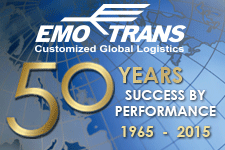|
Headquartered
in Hong Kong, Freightos, the new “online freight
marketplace,” is making headlines as it claims
to have the solution to revolutionizing the cargo market.
If that sounds like a
familiar tune, well, you’ll get no argument from
an increasingly skeptical world.
But like a Brothers Grimm
fairytale, the fantasy that cargo will have a magical
digital solution to bringing costs down, improving transparency
and efficiency, and living happily ever is a common
one.
Whether or not Freightos
will achieve their stated goals or even get within striking
distance of them—let alone deliver on their promise
to “make the process of moving goods around the
world smooth” for everyone— will only be
proved by time.
Here’s a reality
check to separate the wheat from the chaff, bring out
the hard facts, and see what, if anything, is new about
Freightos.
EasyDGR
Redux?
Remember
IATA’s much-touted EasyDGR, the first electronic
solution to digitalize Dangerous Goods documentation,
which was aimed at the shipper?
Easy DGR took off in
2010 and crashed in 2014 after IATA was unable or unwilling
to incorporate the regulatory changes into its own software.
Well, just like EasyDGR,
the Freightos product is SaaS, or “Software as
a Service.” In plain English, the advantage of
SaaS is that one does not need to install servers or
use a specific software platform; instead, the software
functionality is provided by a server—or, in reality,
multiple redundant servers ideally distributed over
the globe so that any disrupted server is compensated
by the others and the workload distributed by means
of load-balancing algorithms.
On the user side, SaaS
requires nothing but a fairly recent web browser. It
can run on anything from an Android-powered smartphone
or tablet to a Linux or Windows workstation. Of course,
like all SaaS solutions, its main strength is the ability
to communicate, so by utilizing defined interfaces such
SaaS solution, Freightos may be integrated into other
IT solutions that already exist.
In reality this means
that AcceleRate, the SaaS database component behind
Freightos, can link up with both legacy and distributed
systems on the airline, forwarder, shipper, and ground
handler side and check for and provide status updates
or simply check for price and availability of cargo
space for a certain shipment.
Where such availability
is given and the price is within defined parameters,
Freightos can book the consignment automatically.
On
The Track of TRAXON
Does
Freightos sound too good to be true?
Actually, no. The Freightos
functionalities described here (albeit in a simplified
manner) were available in the late 1980s from no less
an outfit than TRAXON, which in 2011 was purchased and
subsequently integrated into the CHAMP software suite.
Since in today’s
connected and distributed business world, isolated software
solutions on legacy (meaning defined) hardware platforms
make little sense because any need for expansion, migration,
or further connectivity comes with its own set of issues
and at incalculable cost, most systems are either fully
SaaS or at least interconnected by means of integration.
A very simplified (although
hardly simple) example for SaaS is the eBay website.
eBay allows sellers on
one side to offer their goods and indicate a price,
price range, or just accept bids, allowing buyers on
the other side to buy with confidence, sometimes even
brokering or guaranteeing payments.
So
Who Needs Freightos?
  First, Freightos aims at
all stakeholders in the supply chain. First, Freightos aims at
all stakeholders in the supply chain.
That means Freightos
is not expressly limited to a specific mode of transport
but works generally with all transport modes depending
on a multitude of factors such as budgeted cost and
available service parameters such as cooling, outsized
dimensions, defined transit times, and others.
Freightos works with
“Forwarders/Carriers, Enterprise Shippers and
Ecommerce.”
And while their executive
management team has an impressive record in terms of
experience with digital solutions—CEO Zvi Schreiber
founded Lightech, now GE; COO Victor Ofstein and VP
Product Ruthie Amaru were with IBM; and Fareed Quaddaura
was CTO with Amazon—Freightos appears to have
a missing link in the chain that sticks out like a sore
thumb.
The Freightos Group as
advertised does not appear to have anyone familiar with
what is often called the “human touch” of
cargo.
Will
The Freightos Solution Work?
In a word: certainly.
But will Freightos succeed
and realize a lofty position within the market?
Maybe.
Firstly, putting “Forwarders/Carriers”
in one pot, divided by nothing but a slash, is a question
mark.
If there is anything
IATA and FIATA would agree upon it is that they have
different interests, and that is certainly true for
NVOOCS as well as the big players in the maritime sector.
We can only wonder what
happens when the traditional system of shipper talking
to forwarder and forwarder talking to airline or ocean
carrier—which eventually books and prepares shipment
for transport—is replaced by Freightos.
It is reasonable to expect
current stakeholders will naturally defend their interests
and their business shares, so while transparency is
something everyone claims to want, too much all at once
may be more than stakeholders are prepared to handle
in one fell swoop.
Also, again, because
of the way business is currently done—with shippers
dealing with the actual provider of the transport, such
as the airline—going direct via Freightos can
be viewed as a vertical action in a horizontal shipping
world where, among other things, worldwide cargo markets,
payments of cargoes shipped by forwarders, etc., are
secured by means of an IATA wholly-owned subsidiary,
CASS (Cargo Accounts and Settlement System).
If airlines or shipping
lines have to factor in the risk of late or non-payment
by shippers that would certainly drive up rates and
make the services of forwarders largely superfluous.
Another issue is that
the provision of transport services is usually integrated
with customs clearance, issuance of certain paperwork
(no matter whether in electronic or traditional form),
and the securement, verification, and declaration of
cargo contents. Most of these tasks cannot be carried
out by shippers unless they are large multinationals
with considerable cash to spend on retaining expertise,
certifications, and technology.
In fact, the highly diverse
interests from the stakeholder might prove Freightos’
biggest hurdle. If they deliver what they claim—“frictionless
trade”—then indicating a budget, certain
service parameters, and transit time should be enough
to get an offer for transportation. The more the SaaS
learns, the better its software algorithms (predictions)
will be. “Instantly Compare Freight Quotes, Forwarders
and Modes” and “No hidden surcharges. Ever.”
are good promises.
The wonder is whether
it will be feasible for Freightos to keep them.
So here are options as
to how the Freightos business model might play out:
The first option is that
Freightos fails to balance the diverse interests of
the stakeholders they serve. In this case, Freightos
becomes a niche provider, albeit an important one. But
with Amazon embarking on securing a dedicated air transport
fleet and retailers integrating with supply chain providers,
in this scenario Freightos is outflanked and not dominant.
Another option would
be hammering a square peg into a round hole: Bringing
interest groups such as FIATA, IATA, IMO, and ESC (European
Shipper’s Council) aboard. This way the interests
of stakeholders are balanced against one another, creating
a true win-win situation for everyone while simultaneously
avoiding the hammer of cartel activity fines and the
always eager swarm of hovering lawyers ready to swoop
down on everybody at the behest of regulators.
Your move.
Rasmey Kampuchea |





